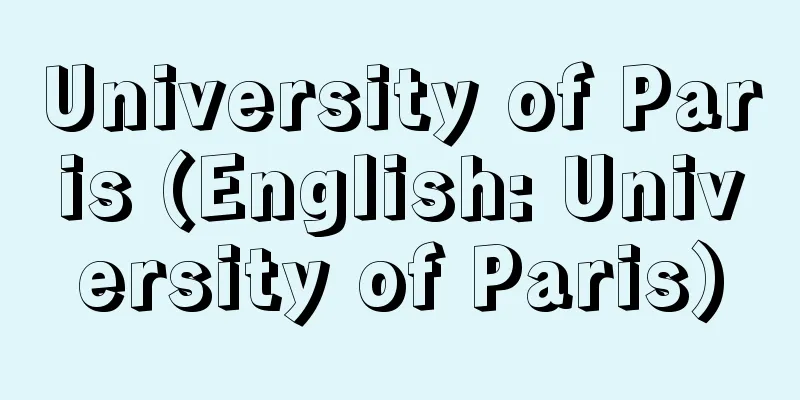University of Paris (English: University of Paris)

|
Founded in the 13th century, it is the oldest university in France. It is commonly known as the Sorbonne. It developed into one of the most prestigious universities in Europe, alongside the University of Bologna (Italy) and the Universities of Oxford and Cambridge (England), but by the mid-20th century it had grown to a mammoth size, with a student population of 200,000 as a single university, and was dissolved in 1968 and reorganized into the 13 new universities, Paris I to Paris XIII, which remain in existence to this day. [Seiji Inoue] historyIt was officially founded in 1215 with the schools attached to the Paris Cathedral as its base. At first, it was a trade association (guild) for the purpose of research and education between professors and students, both of whom were clergy. However, after several struggles for autonomy in the 13th century, it won autonomy from the Pope and the King. From then on, throughout the Middle Ages, the university taught three sciences (grammar, rhetoric, and logic) and four subjects (mathematics, geometry, astronomy, and music) in the bachelor's program (Liberal Faculty), and students who obtained a bachelor's degree could proceed to specialized programs (Theology, Law, and Medicine) that paved the way for master's and doctoral degrees. It guided and nurtured talented people from all over Europe who came to study at the university. The Faculty of Theology was particularly famous, and its central building, the Sorbonne (a dormitory and research building built in the 13th century by the monk Robert de Sorbon (1201-74)), later became synonymous with the entire University of Paris. However, after the Renaissance, the university stagnated, losing its ability to keep up with the progress of modern science, and in the 1790s after the French Revolution, the University of Paris was denounced by the Revolutionary Assembly as a rigid guild organization of scholars and students beyond the reach of state power, and the name university (written as faculté at the time, meaning "specialized university") was banned. However, with the establishment of the Imperial Education System under Napoleon I, the name "faculté" was reinstated. Moreover, the right to award degrees "on behalf of the state" was granted, and at the same time ties with the church were abolished (1806). During the Third Republic, reforms were carried out by Minister of Education Jules Ferry, and two laws in 1893 and 1896 gave the name "université" to a collection of several facultés located in one university district, and thus the "University of Paris" was established with legal personality and financial autonomy. At the same time, a university network of one university per university district (université) was established in the provinces, and this continued to develop in the 20th century. However, at the "Second Caen Conference" (the highest expert conference for the reform of higher education and academic research) held in November 1966, the serious situation of the University of Paris, which already had 200,000 students, or 30% of the total number of university students in the country, was reported, and various reform proposals were considered, including limiting the number of students at each of the 23 universities nationwide to an appropriate level (maximum 20,000) and establishing around 15 universities in the Paris region. After that, in 1968-1969, a student rebellion (May Revolution) sparked by a dormitory autonomy dispute at the University of Paris that shook the world, the traditional way of managing and operating universities was fundamentally questioned, and the groundbreaking "Fundamental Law of Higher Education" was enacted and put into effect in 1969 (Faure Reforms) by Minister of Education Edgar Faure, whose basic principle was "participation." As a result of these reforms, by the early 1970s, 23 universities across the country, including the University of Paris, had been dismantled and reorganized, and ultimately over 70 new universities were established based on new "Unités d'Enseignement et de Recherche" (UERs), which replaced the old faculties (faculties). [Seiji Inoue] Current StatusDuring the reforms at the end of the 1960s, the old University of Paris was dismantled, and the Universities of Paris I to IX were established in the "University District of Paris" within the city, the Universities of Paris X and XI were established in the "University District of Versailles" outside the city, and the Universities of Paris XII and XIII were established in the "University District of Créteil" also outside the city, and they were restarted as new national comprehensive universities open to the public. The 13 universities vary in size and the courses they offer, but one that stands out among them is the University of Paris 8 (commonly known as the University of Vincennes).The university's series of "experimental" systems, such as (1) a significant liberalization of course enrollment, (2) making modern foreign languages and computer science compulsory, (3) accepting students who are exempt from the baccalauréat examination (described below), (4) supporting "lifelong learning" for working adults by offering night, weekend, and summer classes, (5) flexible measures that do not set the number of credits to be earned per year and award bachelor's degrees and other degrees to outstanding students in a shorter period than usual, and (6) active invitation of lecturers from outside the industry and other fields, have had a major impact on the management and administration systems of universities across the country. As with other national universities, admission to these 13 universities is essentially based on passing the baccalaureate exam (a unified national exam that certifies high school completion and qualifies students to enter university), but since there is a tendency for applicants to be concentrated in universities in the Paris region, since the late 1970s many of the 13 universities have implemented their own unique admissions selection procedures for applicants who have obtained the baccalaureate. As of 2000, the total number of students enrolled in all 13 universities is approximately 350,000. [Seiji Inoue] "Reports on Western Universities - Harvard University and the University of Paris" by Kobayashi Yoshiaki (1983, Sanichi Shobo)" ▽ "Studying Abroad at the University of Paris from the Age of 63" by Fujisawa Takashi (1984, Shinchosha)" ▽ "Studying Abroad in France After Retirement" by Hamano Toki (1991, NHK Publishing)" ▽ "French University Students" by Endo Shusaku (1977, Kadokawa Shoten) ▽ "Space of Knowledge - An Architectural Pilgrimage to the Latin Quarter and Quadrangle Campuses (Series 37)" by Iwaki Kazuya (1998, Maruzen) ▽ "Lyrical Self-Portrait" by Okamoto Taro (2001, Misuzu Shobo) [References] | | | |The oldest university in France. It originated from the Sorbonne, which was established by the monk Sorbonne in the 13th century. It developed into one of the most prestigious universities in Europe, but was dissolved in 1968 due to an increase in the number of students, and reorganized into 13 new universities. Paris I to Paris IX are located in the city of Paris. The photo shows the main gate of the University III and University IV campuses in the Latin Quarter. Paris, France ©Masashi Tanaka "> University of Paris (Sorbonne) Source: Shogakukan Encyclopedia Nipponica About Encyclopedia Nipponica Information | Legend |
|
13世紀に創立されたフランス最古の大学。「ソルボンヌ」の通称で知られる。ボローニャ大学(イタリア)やオックスフォード、ケンブリッジ両大学(イギリス)などと並ぶヨーロッパ屈指の名門大学として発展したが、20世紀なかばには単一の大学で学生数20万人を擁するまでにマンモス化したため、1968年に解体され、パリ第一~第十三大学までの13の新制大学に再編され、現在に至っている。 [井上星児] 歴史パリ公教会の付属学校などを母体として、1215年に正式に創立。当初、ともに聖職者身分である教授と学生との研究・教育を目的とする同業組合(ギルド)であったが、13世紀中の前後数回に及ぶ自治権獲得闘争の結果、ローマ教皇と国王から自治権をかちえた。以後、中世全体を通じて、学士課程(自由学部)では3学(文法・修辞学・論理学)と4科(数学・幾何学・天文学・音楽)を教え、学士号取得者にはさらに修士号・博士号への道を開く専門課程(神学部・法学部・医学部)に進ませるなどの制度で、ヨーロッパ全域から学びにくる英才の指導・育成にあたった。なかでも神学部は有名で、その中心的存在であったソルボンヌ学舎(13世紀に僧侶(そうりょ)ソルボンRobert de Sorbon(1201―74)が建設した学寮兼研究棟)は、のちにはパリ大学全体の代名詞ともなった。しかし、ルネサンス期以後は、近代科学の進展についていく能力を失って停滞し、フランス革命後の1790年代には、パリ大学は国権の及ばない学者・学生の硬直化したギルド団体として革命議会に糾弾され、大学(当時の表記はファキュルテfaculté。「分科大学」の意)の名称が禁止された。 しかし、ナポレオン1世の「帝国学制」の確立に伴い、ふたたび「ファキュルテ」の名称が復活された。しかも、「国にかわって」学位を授与する権利が認められ、同時に教会との結び付きが消滅した(1806)。第三共和制期には、文部大臣ジュール・フェリーによる改革が行われ、1893年と1896年の二つの法律により、一つの大学区に所在するいくつかのファキュルテの集合体に「ユニベルシテ」universitéという名称が与えられることになり、ここに、法人格と財政上の自治権を有する「パリ大学」が成立。同時に、地方にも1大学区に1大学(ユニベルシテ)という大学網が確立され、20世紀に入って発展する。 しかし、1966年11月の「第2回カーン会議」(高等教育と学術研究の改革のための最高の専門家会議)では、当時すでに全国の大学生の30%にあたる20万人の学生を抱えていたパリ大学の深刻な状況が報告され、その改革を中心に、全国23の各大学の学生数を適正規模(最大2万人)に抑え、パリ地域圏には15前後の大学を設置する案など、各種の改革案が検討されるに至った。その後1968~1969年の、世界を揺るがしたパリ大学の寮自治紛争を火種とする学生の反乱(五月革命)をきっかけに、伝統的な大学の管理・運営のあり方が根本から問い直され、「参加」を基本理念とする文相エドガール・フォールによる画期的な「高等教育基本法」が1969年制定・施行された(フォール改革)。この改革の結果、1970年代の初めまでに、パリ大学をはじめとする全国23の大学は解体・再編され、最終的には70余の新制大学が、旧来の学部(ファキュルテ)にかわる新しい「教育・研究単位機関」(UER=Unités d'Enseignement et de Recherche)を基盤として発足した。 [井上星児] 現況1960年代末の改革で旧パリ大学は解体され、市内の「パリ大学区」にパリ第一~第九大学が、市外の「ベルサイユ大学区」にパリ第十、第十一大学が、また同じく市外の「クレテイユ大学区」にパリ第十二、第十三大学が設置され、国民に開かれた新制国立総合大学として再出発した。 13の大学の規模や設置する課程はさまざまであるが、それらのなかで大きな特色をもつ大学の一つに、パリ第八大学(通称「バンセンヌ大学」)がある。同大学の(1)科目履修の大幅な自由化、(2)現代外国語と情報科学の必修化、(3)バカロレアbaccalauréat試験(後述)を免除した入学者の受け入れ、(4)夜間クラス・週末クラス・夏季クラスの開設による社会人に対する「生涯学習」支援、(5)学年ごとの取得単位数を定めず、優秀者には通常より短期間で学士号などを授与する弾力的措置、(6)産業界など外部からの講師の積極的招聘(しょうへい)など、一連の「実験的」なシステムは、全国の大学の管理運営制度に大きな影響を与えることとなった。 また、これら13大学の入学者の決定については、一般の国立大学の場合と同様、基本的にはバカロレア試験(高校修了認定と大学入学資格付与を兼ねる統一的国家試験)の合格が必要十分条件であるが、一般にパリ地域圏の諸大学へ志願者が集中しがちであるため、1970年代後半から13大学の多くが、バカロレア資格を取得した志願者に対してさらに独自の入学者選抜を行うようになった。2000年現在、全13大学の在籍者数は、約35万人である。 [井上星児] 『小林良彰著『欧米大学レポート――ハーバード大学とパリ大学』(1983・三一書房)』▽『藤沢たかし著『63歳からのパリ大学留学』(1984・新潮社)』▽『浜野トキ著『定年からのフランス留学』(1991・日本放送出版協会)』▽『遠藤周作著『フランスの大学生』(1977・角川書店)』▽『岩城和哉著『知の空間――カルチェラタン・クォードラングル・キャンパス 建築巡礼(シリーズ37)』(1998・丸善)』▽『岡本太郎著『リリカルな自画像』(2001・みすず書房)』 [参照項目] | | | |フランス最古の大学。13世紀に僧侶ソルボンが開設したソルボンヌ学舎を起源とする。ヨーロッパ屈指の名門大学として発展したが、学生数の増加に伴って1968年に解体され、13の新制大学に再編された。パリ市内にはパリ第一~第九大学がある。写真はカルチエ・ラタンにある第三・第四大学キャンパスの正門。フランス パリ©Masashi Tanaka"> パリ大学(ソルボンヌ) 出典 小学館 日本大百科全書(ニッポニカ)日本大百科全書(ニッポニカ)について 情報 | 凡例 |
<<: Haritake (English spelling) tooth fungi
Recommend
Tetrachord
...The Pythagorean theory was later inherited by ...
Uganda National Congress
… In 1949, after the Second World War, popular ri...
Sutama [town] - Sutama
A former town in Kitakoma County in northern Yaman...
Company - Kaisha
significance In Japan, legal forms of joint ventu...
Laparoscope
...Urethroscopes and cystoscopes are widely used ...
Bone marrow aspiration
This is a test that is performed by taking blood f...
Mermaid
...Their appearances can be broadly categorized a...
Corydalis lineariloba (English spelling)
… [Morita Tatsuyoshi]. … *Some of the terminology...
Shima Doiya
A wholesaler entrusted with selling products from ...
Chivalry - kishidou (English spelling) chivalry
The Christian ethics of life that arose in the kn...
Ohashi Souko
1576-1654 A shogi player from the early Edo perio...
Toraj - Toraj
This is the title of a Korean folk song. It is mo...
Goose neck - Gooseneck
…The calcification of the media varies in degree....
Mortensen, HCC (English spelling) MortensenHCC
...The following is an overview, focusing on bird...
Qom (English spelling)
Qum is a city in Markazi Province in north-central...









